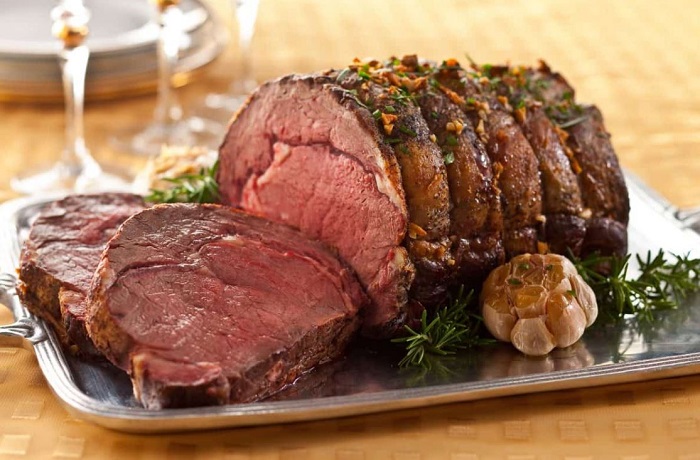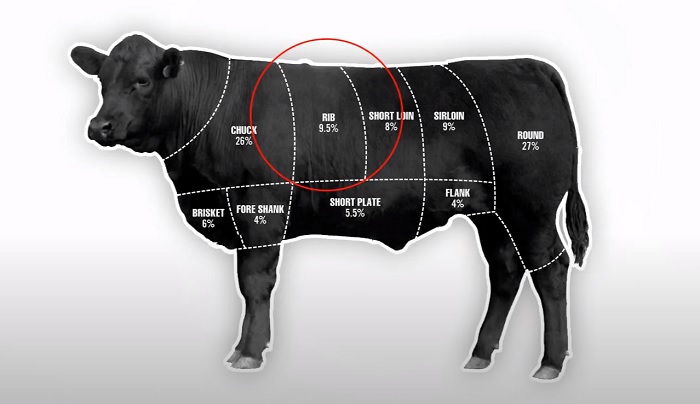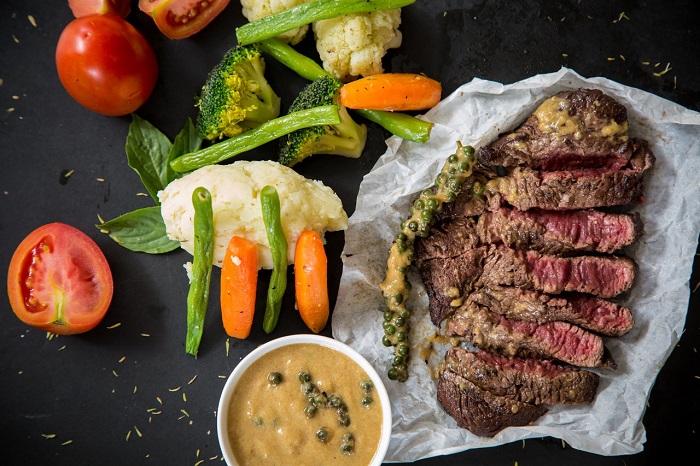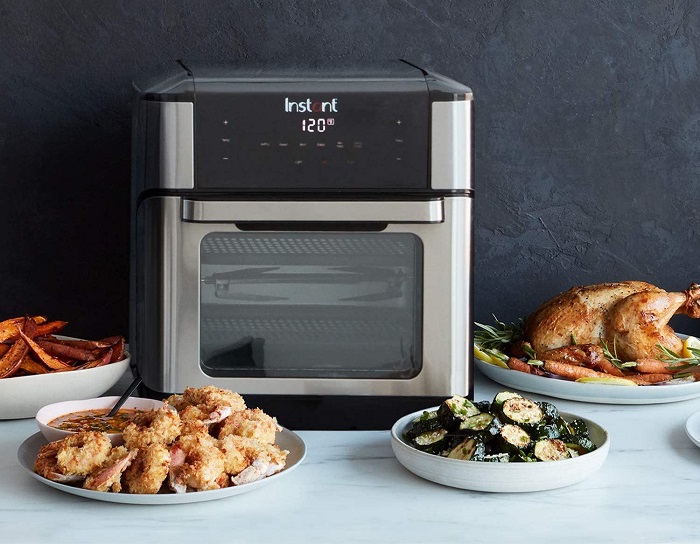What is Prime Rib? Good Tips to Choose and Cook Prime Rib in 2023
Prime Rib is a cut of beef from the primal rib section, and usually consists of ribs 6 through 12. The term “prime” in this case refers to the quality grade given by government graders. Prime Rib is usually roasted for several hours at low temperatures which allows it to cook evenly throughout without drying out or burning on the outside.
A common way that people serve prime rib is with Yorkshire pudding and horseradish sauce, but many other dishes can be made as well like beef Wellington or roast beef sandwiches. Prime rib has become a popular dish due to its tenderness, succulence, and flavorful fat-marbled meat. It’s also often seen at holiday celebrations such as Thanksgiving because it tastes great without being too expensive.
I think above information already answer for the question: What is Prime Rib? So we continue on the article with interesting parts. Let’s see.
The Process of Butchering the Beef
Butchering a prime rib usually consists of separating each rib from its neighboring ribs, and then cutting between each rib to separate it from the spine. Next, you remove any excess fat from around the tenderloin muscle that runs along one side of the cut, but leave some meat on there for flavor.
Finally, after removing all visible sinew and gristle with a sharp knife, you can trim off any thick or thin areas with a band saw to make it more uniform in size and shape. That’s pretty much all there is to it – no big deal!
Reserving the Meat
The most profitable cuts are located along the middle of the rib bones, and that’s where you would want to keep your eye when butchering your prime rib. You can also remove some fat from around those areas to make them more palatable – just make sure that you leave enough meat on there for flavor!
After you’ve finished cutting off as much usable meat as possible, and trimmed off any excess fat or sinew, it is important that you properly label everything so that everyone knows what it is before throwing it in a storage container and freezing.
Label all containers with an expiration date, code indicating its intended use (like “flank steak”, “burger”, etc.), and if applicable specify any special instructions (like “keep separate from other meat”). Make sure that all of your labels are clear, and also get in the habit of writing them down on a notepad or clipboard before storing raw food products. This way you can easily add notes about what kind of meat was stored for future reference.
The primal cuts from a side of beef are often labeled with their intended use – such as “Rib”, “Chuck”, etc. Here these prime ribs have been marked to indicate that they are ready for freezing.
After labeling and packaging, separate each individual piece in your freezer by placing them on top of plastic bags filled with water – this prevents any cold air from getting to your frozen meat (this can lead to freezer burn).
When wrapping food products for long term storage it is recommended that you wrap with plastic before placing them in a freezer bag. This will keep the contents of your bags from getting wet if they get damaged somehow.
If you have any further questions about butchering your prime rib, feel free to comment below – I’ll be glad to answer whatever I can! If you enjoyed this article please consider sharing it with others.
Is Prime Rib come from the same with Prime Grade?
No, not at all. The grade of beef is based on the quality of meat from the animal’s carcass, while prime rib comes from a specific cut of meat that is taken from the ribs near the loin area.
The equatorial line for grading cattle in North America runs along one side of the spine, and it separates two large compartments. Beef graded as Prime will come from what’s known as a “choice” cut of beef – an upper compartment that has high marbling (which means lots of fat) but still lean enough to be considered healthy; this price point is generally reserved for steaks only due to its relatively high cost.
The lower part of the spine contains non-prime cuts that are usually made up of steaks that are well marbled but have a lot of sinew and other undesirable tissue in them. These lower grades are considered the best choice for rough cuts like roasts. Most American consumers prefer to purchase their beef as graded ‘prime’, which is usually only found at high end restaurants or specialty stores.
The term ‘choice’ is generally used to refer to most market-ready cuts of beef simply because it’s far more common than prime – but even then you can bet that some of the meat will be from higher class parts!
In North America, Prime Grade only accounts for about 2% of all cattle sold in Canada and the United States annually; in fact, there’s over 20 million head graded annually across both US and Canadian borders. USDA Choice grade beef accounts for over 80% of all North American cattle sold annually.
The aging process begins once you’ve refrigerated the roast overnight, this will help the meat to firm up and begin absorbing its own natural juices. This is where a lot of people make their first mistake: instead of allowing the prime rib plenty of time to age properly they try to rush things along by sticking it into a warm oven for a while in order to speed things up (don’t do this).
The problem here is that you’re basically trying to cook your prime rib before it’s actually finished cooking, which will result in tougher meat with less flavor – not what we want!
How to choose a good Prime Rib?
There are two things to look for when shopping for a prime rib roast: color and marbling.
Color is an indication of the age of the meat, the darker the ruby red color (or brown in some cases) the older it is – don’t worry! As long as you’re buying your beef from a reputable butcher it should be safe to eat regardless of how dark it looks. In fact, many butchers will let customers choose which cut they want based on visual appeal alone – go ahead and pick one that looks appealing to you!
Marbling refers to uniform flecks of fat within those ruby red layers; this is also an indicator of quality/tenderness and helps ensure that your prime rib will be tender once its cooked. If you look at the picture below you’ll see that this roast is pretty evenly marbled (that’s a good thing).
What Temperature to Cook Prime Rib?
The USDA recommends cooking your prime rib roast to somewhere between 135-145 degrees F, but most chefs and enthusiasts will tell you that this is overkill – I’ll explain why below. The first thing we need to know when cooking our prime rib is what temperature it should be prepared at before being cooked; the goal here is not only to achieve a perfectly cooked piece of meat, but also one that retains as much moisture as possible.
Cooking roasts with low internal temperatures leads to loss of natural juices during the process and often results in dry, tough meat once it’s finally fully cooked. The reason for this is the collagen – a basic form of connective tissue that can be found in both animal and plant tissue (this stuff is important!).
Prime rib has plenty of collagen running through it, but it’s especially prevalent in the cartilage near the bone; as meat cooks its collagen turns into gelatin – this helps add moisture to whatever you’re cooking and also results in a more tender piece of meat (the more marbling in your prime rib roast, the better).
When we cook our prime rib at higher temperatures above 145 degrees F we force some of that extra moisture out almost immediately; instead what I recommend doing is cooking your prime rib at 115-120 degrees F until around 90% done, then raise the heat to ~300 degrees F and allow it to finish for 15-20 minutes.
This will result in a perfectly cooked piece of meat that still retains plenty of moisture due to the low internal temperature during most of its cooking time.
Why is keeping your prime rib cold important?
The main reason we chill our prime rib roast before cooking is because we want to limit oxidation (the constant exposure to air will cause some forms of proteins like myoglobin, which gives meat its red color, oxidize into brown metmyoglobin). These chemical reactions not only deteriorate the meat’s flavor and appearance over time, but also extend cook times since any natural moisture inside the meat is now being exposed to air instead.
How do you marble Prime Rib Roast?
Now that you understand the role marbling plays in producing a tender piece of meat its important to know how it can also affect your final product.
You may have noticed that some prime rib roasts have more pronounced veins of fat running through them than others – this is because these roasts were mechanically separated; what this means is that any remaining marrow, intermuscular fat and connective tissue has been manually scooped out with something like a picker tool or similar instrument.
Where we can buy Prime Rib?
Firstly, you know “What is Prime Rib?”- as above introduction.
Secondly, Prime rib can be found in most supermarkets in the meat counter, but it’s usually a good idea to call ahead and ask if its available. When I asked my local supermarket about their prime rib they told me that they keep it cold until an order is placed for it (this makes sense because this roast doesn’t last as long as most others) – not only that, but the price fluctuates depending on market demand!
How to Cook Prime Rib Roast?
After years of trial and error I’ve finally settled on what method works best for cooking my prime ribs; instead of roasting the entire piece of meat at a high temperature I like to start out at around 120 degrees F until around 90% done, then raise the temperature to ~300 degrees F until its fully cooked. This results in a perfectly cooked piece of meat that still retains plenty of moisture due to the low internal temperature during most of its cooking time .
You can cook your prime rib in pretty much any oven you have lying around, but I like to use my sous vide machine for this; not only do you get accurate temperature control, but it also ensures that the entire roast cooks evenly.
Depending on how big your roast is (I often buy ones weighing up to 16 lbs) it will have different levels of thickness all across it; because the heat doesn’t hit every inch at once it’s important to rotate your prime rib roast 90 degrees every 15-20 minutes during the process.
It’s also important to remember that your roast will increase in temperature by about 5 degrees once you remove it from the water bath; this is due to the fact that muscle fibers tighten up as they get closer to their final resting temp.
How long do I cook Prime Rib?
We already know “What is Prime Rib?” as above now, we will know how long to cook it. According to USDA guidelines, a medium rare prime rib with an internal temp of 125-130 degrees F should have been cooked at around 135-140 degrees F for between 12-15 minutes per pound (most recipes out there tell you stuff like ‘cook until 120 degrees’ which don’t really account for all of this).
As you can guess, cooking at lower temperatures for longer periods of time results in a much more tender piece of meat than anything else – but how can you test if its done? The best way to tell is by penetration; if you stab your knife into the meat and it slides in easily (but not like butter) then that roast is almost ready.
How long do I rest Prime Rib Roast?
I know waiting around for your food for an hour or two can be painful, but I promise this step will make a huge difference in terms of texture and moisture retention throughout the entire piece of meat.
Why? After cooking any animal protein its important to allow them time to relax – the mechanical act of cooking causes all sorts of proteins within the flesh to tighten up quite rapidly as they reach their final temp; because these structures are still very tightly wound they’re holding on to any stored moisture in them very tightly.
If you cut into your roast right away you’ll release that stored moisture, resulting in dry and potentially tough meat. Letting it rest allows the muscle fibers to relax and unwind a bit, meaning they won’t be holding onto as much moisture when you cut into it – this is why using a sharp knife or electric carving knife also makes a huge difference.
How do I carve Prime Rib?
As you know “What is Prime Rib?” as above information, now you will know hoe to carve it. There are several different ways of slicing or carving prime rib; traditionalists will tell you to slice against the grain before eating while others prefer larger chunks that don’t require all those strokes from their fancy knives:
This is what properly cooked prime rib should look like when sliced with the grain
The finished product – look how juicy it still is!
And this is what prime rib looks like when sliced against the grain
(Notice a difference?)
As you can see, cutting against the grain causes some parts of your meat to be very tough and stringy (which might explain why so many people cut their roasts in half prior to cooking them); as I’ve learned from my friends who are butchers (and yes, they have much larger knives) slicing with the grain allows for a smooth cut that requires less effort.
If you’re not sure whether or not you should slice with or against the grain check out this awesome diagram here ; hopefully it clears up any confusion! Another option is to shred your beef using 2 forks:
The resulting product is perfect for use in sandwiches or tacos; I often buy extra prime ribs and freeze them to be used later!
What are some of your favorite Prime Rib recipes?
Once you know how to make a good prime rib roast its easy to apply the same skills towards other dishes – brisket and short ribs are great with a nice rub applied before baking, while chicken will turn out excellent when baked using the water bath method. If you have any tips that don’t seem to fit elsewhere please share them below; Happy Cooking everyone!
For those of you who are interested, here’s a transcription of all of our notes from our night together:
- 12 Prime Ribs.
- 1 bags Pepperidge Farms 80/20 meat.
- 6-8 ribs Superior Farms beef bones, marrow and all 2.5 lbs of each 1 rack 80/20 (split into two) 3 lbs+2Tbsp onion powder 4 oz+1Tbsp garlic powder.
4 degrees off Shoulder = 8 oz / lb not 5 16oz of salt, 10oz only needed for the roast 14 Cups water for cooking – used about half One roll butcher paper Everything was nose down, wrapped in parchment paper Roasted at 300F for 4 hours then 90F for ~3h 15min 50 degrees pulled out first one to be sure it did not burn First rib taken out at this point sliced against grain (see note above regarding slicing method).
Then we started taking them out every 30 minutes to an hour One pulled out at 3.5 hours and then I used a thermometer to pull them all at about 130-135ish degrees Internal temp was 150F.
Dry aged/aged prime rib on the left, caged meat on the right.
See how much thinner and more brittle its getting? That’s what we want! Nice and dry Fat thickness: Standard – 0.25″; Select – 0.15″; Prime – ~0.12″ after 6mo of aging Pan Sear Method for Roast obtained from Heston Blumenthal’s In Search Of Perfection Gotta be careful with this one or you’ll turn your beautiful roast into shoe leather Season with salt & pepper (high heat!).
Until golden brown then lower heat to medium (maybe 275) and cook for ~30min Sear on other side for another 30min Let it rest/cool down the unwrap, season with salt & pepper again, cover in plastic wrap and then put a towel over the top of that Cover in foil after 24h or so and leave at room temp until ready to slice – 2 days Prime Rib Roast.
For those of you who are interested, here’s a transcription of all of our notes from our night together: 12 Prime Ribs 1 bags Pepperidge Farms 80/20 meat 6-8 ribs Superior Farms beef bones, marrow and all 2.5 lbs of each 1 rack 80/20 (split into two) 3 lbs+2Tbsp onion powder 4 oz+1Tbsp garlic powder.
4 degrees off Shoulder = 8 oz / lb not 5 16oz of salt, 10oz only needed for the roast 14 Cups water for cooking – used about half One roll butcher paper Everything was nose down, wrapped in parchment paper Roasted at 300F for 4 hours then 90F for ~3h 15min 50 degrees pulled out first one to be sure it did not burn First rib taken out at this point sliced against grain (see note above regarding slicing method).
Then we started taking them out every 30 minutes to an hour One pulled out at 3.5 hours and then I used a thermometer to pull them all at about 130-135ish degrees Internal temp was 150F
Quick Tips for cooking Prime Rib
1. Never let the Prime Rib out of your sight!
The biggest mistake is to take it out when you think its done and then have it dry up in your oven. You want to pull it at the lowest temperature so that you can bring back the temperature during resting time for good color, texture and flavor.
2. Seasoning Prime Rib:
Salt helps break down protein strands (denaturing) making them more tender and also adds flavor while pepper has a flavor impact without adding much moisture.
3. Internal meat thermometer
This is very important as most roasts are cooked to rare, medium or well done these days but they should be cooked as follows: Rare – 1st rib 160°F Medium Rare – 1st rib 145-160°F Medium – 1st rib 140-145°F Well Done – 1st rib – 125°F 4. Resting time: allow at least 45 minutes to an hour and up to several hours depending on the size of the roast that you have cooked.
During this time, do not carve it or disturb it in any way – just let it rest in a warm place away from drafts (or leave it covered with foil in your oven) so that the temperature inside is even throughout and once its rested, then carve it when you’re ready to serve 5.
Carve Prime Rib: Leave Prime Rib roast whole if possible – make scalloped edge slices across the grain by slicing perpendicularly to how they are connected – this will have a chewy texture while providing the best flavor 6. Roasting vegetables in the same pan as Prime Rib – this will add great flavor and color to your veggies.
How Long to Cook Ribs in Oven at 350 Without Foil?
Probably not that long, though it does depend on the size of the rack you are cooking. You’ll want to check in with us at about 30 minutes from your desired finished temperature or when a meat thermometer inserted into the thickest part of the ribs reaches an internal temperature of about 145 degrees Fahrenheit.
We use a combination of fresh and dried herbs in our rubs. For fresh herbs, we always choose flavorful varieties with as little stem attached as possible (thus preserving more flavor) and try and use them within a week or so since they tend to dry out quickly once harvested. If only dried herbs are available, be sure to rehydrate them before using for best results in terms of taste, aroma and texture.
Once you have your herbs, mix them together and then rub or brush liberally on the meat. Don’t forget to season the meaty side of bones with a generous amount of salt and pepper. We always like to add some additional spices for extra impact such as chili powder, cayenne pepper or hot sauce. Remember that many dried herbs are much stronger than their fresh counterparts so adjust accordingly!
For this chef’s tip guide regarding ribs , we’re going to talk about dry aging . What is it? Dry aging is simply letting your rib roast sit in a refrigerator at room temperature for 2-3 days before cooking. In theory, this dries out the meat like wet aging would but without using any kind of chemical additives/solutions which can be harmful to your health. Why would you want to dry age?
The main reason is for the extra flavor that comes with dry aging and by allowing the rib roast to dry out and develop a honeycomb texture on the surface of the meat. When it’s cooked, this creates this smokey taste and a contrast in textures that many find very desirable but it can also be risky since there’s no guarantee that your Prime Rib will turn out as you hoped it would.
Conclusion
Prime rib is a cut of beef from the most tender part of the cow. The meat comes from the primal ribs, which are near to where they attach to the spine and thus have some marbling that makes them flavorful. This area also does not work as hard so it has less muscle fibers hence making this steak one of the tenderest cuts in all meats.
You might find prime rib at your local grocery store or butcher shop but if you want top quality, we recommend going straight to a specialty purveyor like us here at our family business! If you’re looking for more information on buying prime, read the information above. We hope this helped answer any questions about what is Prime Rib? And if you have more concern, just write us an email so that we can check and reply you. Thank you!





